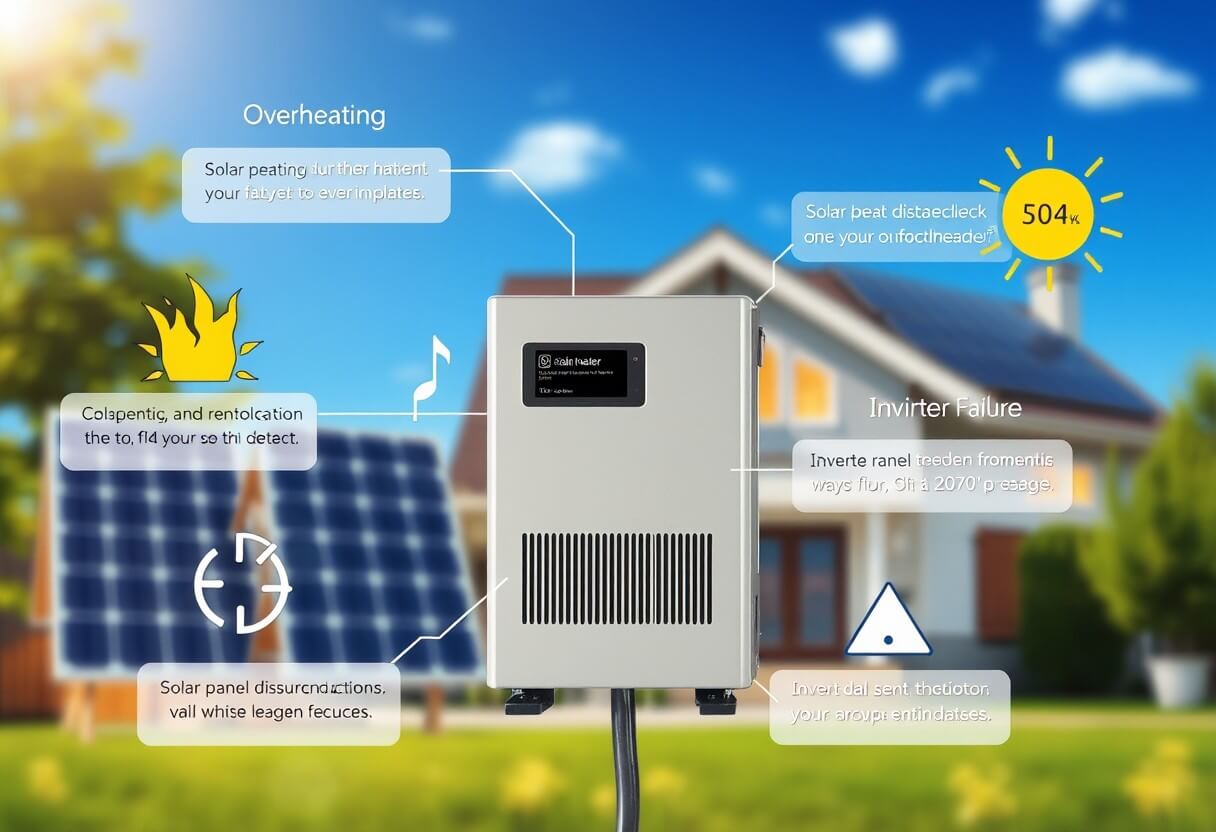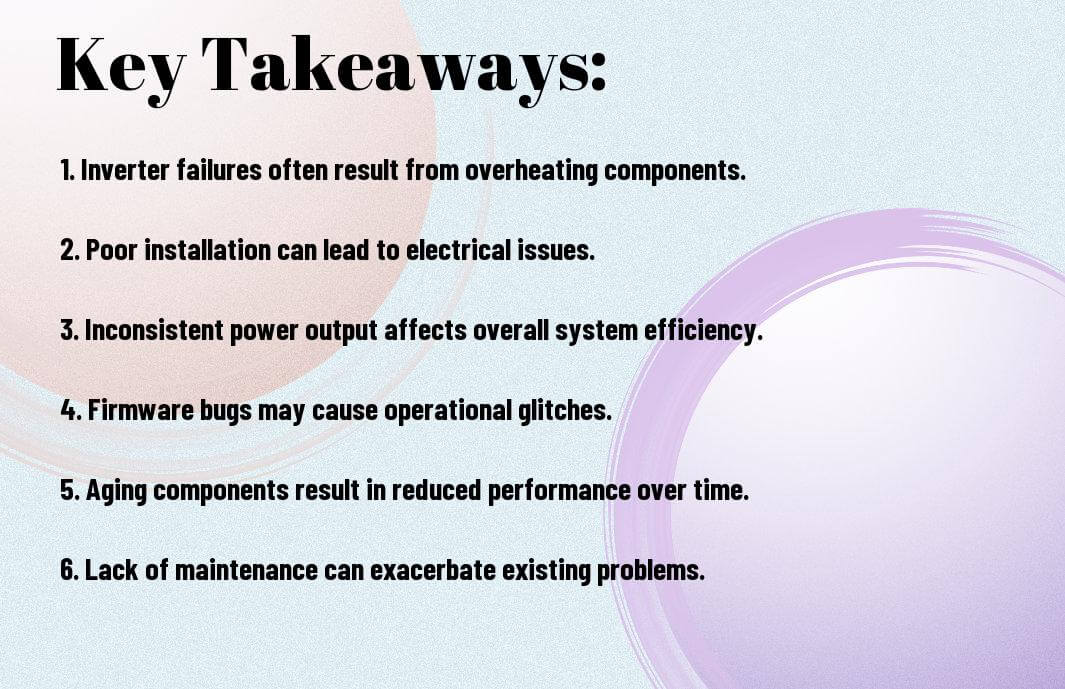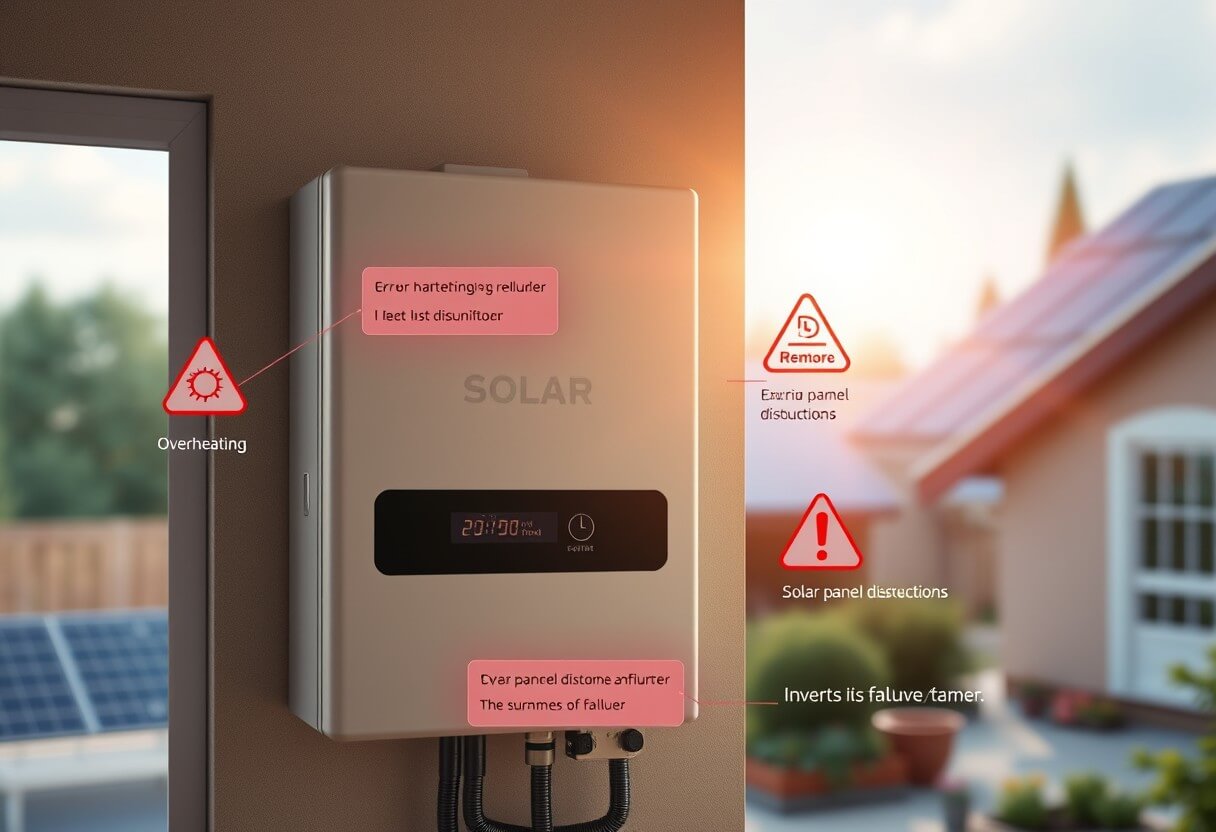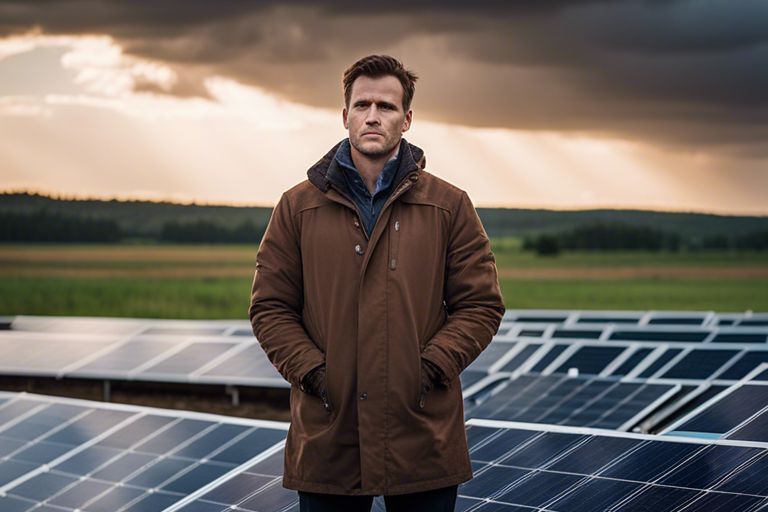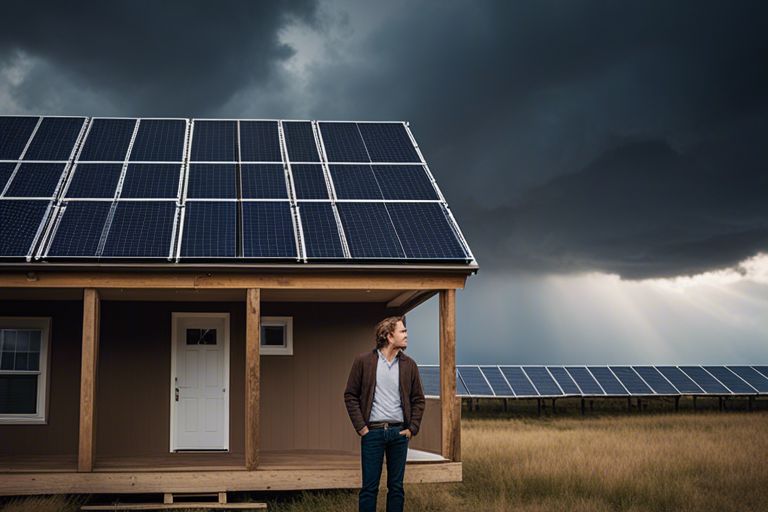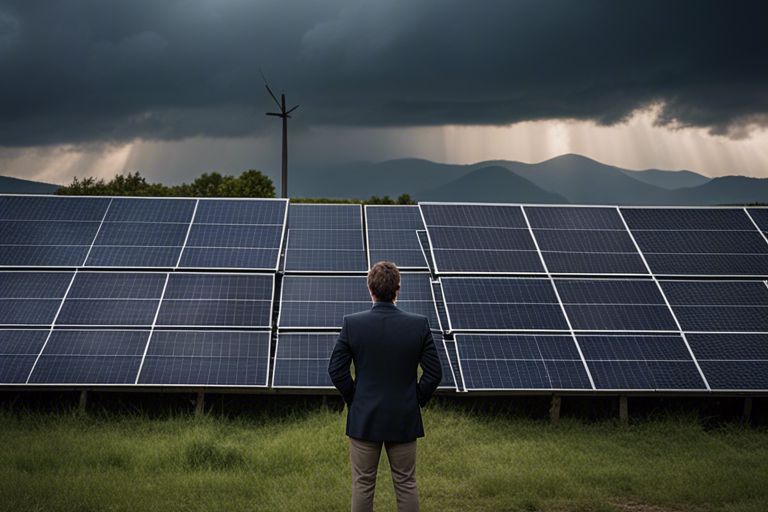Faulty inefficiency is one of the most prevalent issues you may encounter with your solar inverter. This critical component is crucial for converting the direct current (DC) generated by your solar panels into usable alternating current (AC) for your home. If your inverter is not functioning optimally, it can lead to decreased energy production and higher electricity bills. Understanding common problems, such as overheating, connectivity issues, or performance degradation, can help you maintain your solar system’s efficiency and ensure you get the most out of your investment.
Key Takeaways:
- Overheating: Solar inverters can experience overheating, which reduces their efficiency and might lead to failure if not properly managed.
- Connection issues: Poor connections, whether in wiring or monitoring systems, can hinder performance and result in energy loss.
- Firmware bugs: Firmware issues can cause malfunctions or erratic behavior in solar inverters, impacting their operational reliability.
- Lightning strikes: Inverters are susceptible to damage from lightning strikes, making surge protection a necessity for safe operation.
- Age-related degradation: As solar inverters age, their components may degrade, leading to decreased functionality and the need for replacement.
Overview of Solar Inverters
For anyone considering investing in solar energy, understanding solar inverters plays a crucial role in harnessing the full potential of your solar energy system. Solar inverters are devices that convert the direct current (DC) produced by solar panels into alternating current (AC), which is the type of electricity used in your home or fed back into the grid. By efficiently managing this conversion, solar inverters ensure that you can utilize the energy generated by your solar panels effectively.
Definition of Solar Inverters
On a fundamental level, a solar inverter is an necessary component of your solar energy setup. It not only transforms electrical current but also performs several vital functions, such as maximizing energy production, monitoring system performance, and providing services that improve the reliability of solar power systems. It ensures that your solar energy generation is both efficient and sustainable, making it a key player in the solar energy landscape.
Types of Solar Inverters
On your journey to selecting the right solar inverter, you will come across various types designed to meet different needs and installation scenarios. The primary types include string inverters, microinverters, and power optimizers. Each type has its advantages and specific use cases that will influence your decision. Whether you have a residential system or a larger commercial installation, understanding these options will help you choose an inverter that aligns with your goals.
| Type | Description |
|---|---|
| String Inverters | They link solar panels in series – commonly used in residential systems. |
| Microinverters | Attached to individual solar panels, optimizing performance at a panel level. |
| Power Optimizers | They work alongside string inverters, enhancing energy collection from each panel. |
| Hybrid Inverters | They combine functions of inverters and battery chargers, facilitating energy storage. |
| Central Inverters | Designed for large-scale solar installations, handling a significant number of panels. |
To further your understanding of solar inverters, it’s necessary to realize that there are significant differences in their functionalities, efficiencies, and suitable applications. Depending on your specific solar setup and energy needs, choosing the right type can maximize your energy output and savings in the long run. For instance, microinverters may be ideal for installations with shading concerns, while string inverters might suffice for straightforward applications without such issues.
| Advantages | Considerations |
|---|---|
| Efficiency | Performance can be impacted by shading or orientation. |
| Cost-Effective | Initial investment might vary based on technology. |
| Scalability | Can be adjusted or expanded easily in many systems. |
| Monitoring | Some systems offer advanced monitoring capabilities. |
| Reliability | Quality can vary based on manufacturer and model. |
Importance of Solar Inverters in Solar Energy Systems
Power management is crucial for the efficiency of any solar energy system, making inverters necessary. They play a pivotal role in converting energy to a format usable in your home, ensuring that the solar panels can produce power efficiently. Without a solar inverter, the energy generated by your solar panels would be ineffective, as most household appliances and the electrical grid operate on AC power. Therefore, the inverter bridges the gap between renewable energy generation and practical utilization.
Moreover, a good-quality inverter helps in optimizing the energy generation from your entire solar panel array. By keeping track of conditions like temperature and shading, your inverter can adjust to maximize energy capture. This not only ensures that all components of your solar energy system work seamlessly together but also enhances the longevity of your solar panels. Investing in a reliable solar inverter ultimately contributes to maximizing your return on investment.
String inverters are particularly popular due to their cost-effectiveness and simplicity. They group multiple solar panels together, making them easy to install and maintain. However, it’s necessary to consider how this design can affect solar energy capture, especially in instances where shading might occur on a portion of the panel array. Therefore, understanding your unique installation scenario is key to determining whether string inverters or another type would be more appropriate for your specific needs.
Common Problems in Solar Inverters
Unlike other components of a solar power system, solar inverters can encounter specific problems that affect their performance and longevity. Understanding these common issues will help you diagnose potential problems early and ensure your system operates efficiently.
Performance Issues
One of the most prevalent problems with solar inverters is related to performance. You may notice a drop in energy production, which can be a result of various factors such as shading on the solar panels or issues with the inverter’s settings. Regular monitoring of your solar energy output can help you identify when performance issues arise, allowing for timely intervention.
Another aspect of performance issues is the inverter’s ability to handle varying weather conditions. In areas that experience frequent fluctuations, extreme temperatures can lead to efficiency declines. It’s crucial to be aware of how weather affects your solar system and consider maintenance to mitigate any adverse effects.
Hardware Failures
With constant exposure to the elements, hardware failures in solar inverters can occur over time. You might face issues such as blown fuses, burnt-out components, or even complete system shutdowns due to extreme weather events. Identifying these hardware problems early allows you to make necessary repairs and avoid further damage to your solar system.
For instance, a common hardware failure is the deterioration of capacitors, which are crucial for the inverter’s operation. If left unchecked, this can lead to increased energy losses. Regular inspections and maintenance can aid you in catching these failures early, keeping your system running optimally.
Software Malfunctions
Solar inverters also face the risk of software malfunctions, which can severely impact their performance. You may experience issues like errors in data logging, notifications about system faults, or even the inability to connect to monitoring platforms. Staying updated with the inverter’s firmware can help in resolving many of these problems before they escalate.
Issues related to software comprise outdated firmware that may not be compatible with new updates or occasional bugs that can disrupt operations. Regularly check your inverter’s software version and visit the manufacturer’s website for updates to maintain the efficiency of your solar energy system.
Diagnostic Tools and Techniques
Now, understanding the common issues with solar inverters is key to effective troubleshooting. The right diagnostic tools and techniques can streamline this process, ensuring that you can identify problems quickly and efficiently. Familiarizing yourself with these tools is crucial, and for those looking for comprehensive resources, you can explore Solar Inverter Problems: Our 8-step Troubleshooting Guide.
Performance Monitoring Systems
With the advancement of technology, performance monitoring systems have become an imperative tool in managing your solar inverter’s efficiency. These systems provide real-time data on energy production, allowing you to identify any deviations from expected performance. By utilizing these systems, you can track your solar inverter’s performance trends over time, making it easier to spot anomalies that may indicate underlying issues.
Moreover, many modern solar inverters come equipped with built-in monitoring capabilities, which can alert you to faults or underperformance automatically. Regular monitoring can help you address problems before they escalate, saving you both time and money in the long run.
Visual Inspections
On the other hand, visual inspections are a fundamental yet often overlooked aspect of solar inverter diagnostics. Performing a thorough visual check can reveal a multitude of issues—from loose connections and physical damage to signs of overheating. Regularly inspecting your solar inverter, especially after extreme weather events, can help you catch potentially serious problems early.
Additionally, inspecting the wiring and connections for signs of wear or corrosion can be invaluable in preventing further damage. It’s advisable to familiarize yourself with the main components of your inverter system, allowing you to conduct effective visual inspections.
Visual checks can often avert significant problems that could lead to costly repairs. A simple examination can demonstrate whether safety indicators are functioning correctly and whether the inverter is appropriately ventilated and free of obstructions.
Electrical Testing Equipment
Electrical testing equipment is another critical tool in your diagnostic arsenal. This category includes devices such as multimeters, insulation testers, and clamp meters, which can help measure voltage, current, and resistance in your solar inverter system. By utilizing these tools, you can assess whether the system is functioning within designated parameters.
Additionally, electrical testing equipment can assist in pinpointing specific issues like grounding problems or circuit faults. Regular use of this equipment can help ensure that your solar inverter operates efficiently and safely, allowing you to maintain optimal performance.
Plus, employing electrical testing equipment can lead to more precise diagnostics that visual inspections alone might miss. This equipment can provide quantitative data that can help inform your maintenance decisions and ensure your solar inverter continues to operate effectively.
Preventive Maintenance Strategies
Your solar inverter is a critical component of your solar energy system, and just like any other machinery, it requires regular maintenance to ensure optimal performance. This chapter outlines key preventive maintenance strategies to help you extend the lifespan of your solar inverter and prevent common problems. For further details, you might find it helpful to explore What are the Common Problems with Solar Inverters? to understand issues that can arise without proper maintenance.
Regular Cleaning and Inspections
The first step in preventive maintenance is to conduct regular cleaning and inspections of your solar inverter. Dust and debris can accumulate on the inverter and affect its efficiency, leading to overheating or malfunction. By routinely inspecting the inverter and cleaning it as needed, you can ensure it operates smoothly and reliably. Aim to perform these checks at least twice a year, or more often if your inverter is located in a dusty or dirty area.
Additionally, during your inspections, check for any signs of wear or damage. Look for loose wires, corrosion, or any unusual sounds that might indicate a problem. Catching issues early on can save you from costly repairs and downtime in the future. Establishing a maintenance log can help you track your inspections and any issues that arise, ensuring that your solar inverter remains in good working condition.
Proper Installation Practices
Any successful solar system starts with proper installation practices. The installation of your solar inverter should comply with local regulations and manufacturer recommendations. Poor installation can lead to numerous problems, including overheating, system failures, and even safety hazards. If you are not experienced in solar system setups, it is crucial to hire qualified professionals to carry out the installation.
Proper installation involves taking into account the inverter’s location, ensuring it is placed in a cool, ventilated area away from direct sunlight. Make sure that the wiring is correctly done to prevent any accidental short circuits, and that all connections are secure. This initial step can drastically reduce potential complications down the line, allowing your inverter to function as intended.
Scheduled Software Updates
Software maintenance is another crucial aspect of ensuring optimal inverter performance. Software updates provided by manufacturers often include improvements that enhance efficiency and safety, as well as bug fixes that address known issues. By scheduling regular software updates, you can take full advantage of these enhancements and help mitigate any technical problems that could arise from outdated software.
Regular software updates not only keep your inverter functioning efficiently but also improve its security. Cyber threats are a growing concern in the digital age, and manufacturers frequently release security patches to address vulnerabilities. By staying on top of software updates, you ensure that your inverter remains secure and operates without any disruptions.
Updates should be checked automatically or scheduled manually, depending on your inverter’s capabilities. It is advisable to keep a close eye on the manufacturer’s announcements related to software upgrades to never miss an important update.
Troubleshooting Common Problems
Not all solar inverters are created equal, and while they are generally reliable, various issues can arise that impact their performance. Understanding how to troubleshoot these common problems can make a significant difference in maintaining the efficiency of your solar energy system. You may find that addressing these issues promptly not only saves you time but also ensures that you’re getting the most out of your investment.
Identifying Symptoms
Common signs of an inverter problem include error messages on the display, unusual noises emanating from the inverter, or the system failing to produce energy. You might also notice that your electric bill is higher than expected, which can indicate that your solar system isn’t generating the energy it should. It’s imperative to keep an eye on the inverter display and your monitoring application to catch these issues early.
Also, pay attention to your system’s performance on cloudy or stormy days, as inverters can sometimes struggle under specific weather conditions. Checking the LED indicators can also provide insight; a red light often indicates an issue that needs addressing. Regular maintenance checks can help you identify these symptoms before they escalate into more significant problems.
Step-by-Step Repair Guide
To effectively troubleshoot and repair common inverter problems, it’s helpful to have a structured approach. Below is a practical step-by-step guide that can assist you in resolving most issues you may encounter with your solar inverter:
| Step 1: Turn Off the Inverter | Ensure your safety by switching off the inverter before attempting any repairs. |
| Step 2: Check Connections | Inspect all wiring and connections to ensure they are secure and undamaged. |
| Step 3: Reset the Inverter | Sometimes a simple reset can resolve temporary glitches in the system. |
| Step 4: Inspect for Overheating | Check if the inverter is excessively hot, which could indicate ventilation issues. |
| Step 5: Consult the Manual | Refer to your inverter’s manual for error codes and specific troubleshooting advice. |
| Step 6: Contact a Professional | If the problem persists, reach out to a certified technician for a thorough check. |
With the above guide in hand, you should feel more equipped to tackle common inverter issues. Additionally, keeping thorough records of any problems and repairs can provide valuable insights for future reference. By regularly maintaining your system and following these steps, you can ensure its longevity and continued optimal performance.
| Tip 1: Regular Monitoring | Utilize monitoring apps to track your system’s performance in real-time. |
| Tip 2: Schedule Maintenance | Set up regular maintenance checks with a professional to catch potential issues early. |
| Tip 3: Keep the Inverter Clean | Ensure the inverter is free from dust and debris to promote optimal cooling. |
| Tip 4: Understand Local Regulations | Be aware of your local regulations regarding solar energy systems for compliance. |
Cost Implications of Inverter Issues
To navigate the complexities of solar inverter issues, understanding the cost implications is crucial. Your inverter is a significant component of your solar energy system, and any problems that arise can lead to unexpected expenses. Whether it’s a minor malfunction or a more severe failure, the financial strain associated with inverter issues can impact your overall energy savings and return on investment. Consequently, being aware of potential costs allows you to make informed decisions regarding maintenance and troubleshooting efforts.
Repair vs. Replacement
On facing inverter issues, one of the early decisions you will need to make is whether to repair or replace the unit. Repairing your inverter can be a more cost-effective solution, particularly if the problem is minor and can be addressed quickly. However, frequent repairs may indicate it’s time to consider a replacement. Weighing the costs of ongoing repairs against the price of a new inverter can help you clarify which option offers the best long-term financial benefits.
On the other hand, replacement may be the wiser choice if your inverter is several years old or suffering from a more significant malfunction. While the initial outlay for a new inverter may seem daunting, modern units often come with improved technologies and warranties, potentially translating to higher efficiency and lower long-term costs. Therefore, evaluating the age, reliability, and performance of your current inverter is crucial in making this fundamental decision.
Long-Term Financial Impact
Inverter issues can have far-reaching consequences on your long-term financial plans. Increasingly high repair costs combined with downtime in solar energy production can significantly affect your electricity savings. If your inverter fails and requires extended service or replacement, you may face interruptions in the energy output, which negates the savings you worked hard to achieve. Additionally, you should consider that the longer you delay addressing inverter issues, the more severe and costly future problems may become.
Inverter performance is directly tied to your solar system’s efficiency, meaning that poor management of inverter problems not only incurs immediate expenses but could also jeopardize long-term savings. A reliable inverter is key to maximizing your solar investment, and addressing issues promptly can mitigate potential financial losses over time.
Insurance and Warranty Considerations
To protect yourself financially from inverter issues, it’s vital to understand the role of insurance and warranties. Many homeowners assume that standard homeowner insurance will cover solar panel and inverter failures; however, this is not always the case. Reviewing your insurance policy and discussing options with your provider can help clarify what is protected and any exclusions that may be in place, allowing you to safeguard your investment adequately.
To further reduce financial risks, you should also consider solar inverter warranties. Warranties often cover parts and repairs for a specific period, providing peace of mind that your investment remains protected against manufacturing defects or significant failures. Before purchasing a solar inverter, be sure to read the warranty terms carefully and determine if an extended warranty might make sense based on your financial planning.
Warranty coverage can serve as a crucial financial buffer against unexpected inverter failures. Many reputable manufacturers offer warranties that can last from 5 to 10 years or longer, ensuring that your costs are mitigated should something go wrong. When you secure a solid warranty, you protect your finances while also ensuring reliability in your solar energy production.
Future Trends in Solar Inverter Technology
All across the renewable energy sector, an evolution is taking place, particularly within solar inverters. Advancements in technology are helping to address the common issues outlined in resources like 5 Most Important Solar Inverter Problems + guide to solving. As you look to invest in solar solutions, understanding these future trends will empower you to make informed decisions that ensure your system operates effectively and efficiently for years to come.
Advances in Smart Inverters
Trends in smart inverter technology are making them increasingly sophisticated. These devices can now communicate with the grid, allowing you to not only monitor energy production in real-time but also manage it efficiently. Smart inverters help optimize the performance of your solar energy system by automatically adjusting to changing weather conditions and your energy consumption patterns. This adaptability not only boosts your energy production but also minimizes waste.
Furthermore, you will find that advanced functions like grid support—where smart inverters can provide voltage regulation and frequency support—are becoming more commonplace. This not only enhances the overall resilience of the electric grid but makes your solar power system more reliable. By leveraging these smart technologies, you position your solar investment to keep pace with the evolving energy landscape.
Integration with Energy Storage Solutions
Solar energy is naturally intermittent, which can complicate its use. However, trends in energy storage technology are changing that dynamic. Solar batteries are becoming more affordable and efficient, enabling you to store excess energy for later use. This means you can power your home even when the sun isn’t shining, thus increasing your energy independence.
Plus, coupling solar inverters with energy storage systems allows for better management of your electricity usage. This integration not only improves self-consumption but can also provide backup power during outages. As energy regulations and utility rates evolve, you’ll find that having an energy storage solution enhances your overall solar investment, allowing for greater flexibility and efficiency.
Enhancements in Durability and Efficiency
Smart inverter technology is also focusing on durability and efficiency, factors that are critical for the longevity of your solar power system. Modern inverters are built to withstand harsh environmental conditions, ensuring that they continue to perform optimally over time. With improved thermal management technologies and robust materials, these devices are more resilient to extremes of heat and humidity.
Additionally, efficiencies are reaching new heights, which means you can expect higher energy yields from your solar system. Innovations in design and engineering are constantly being rolled out, ensuring your investment in solar pays off with every unit of energy generated. As you consider future upgrades, you’ll want to keep an eye on these enhancements to sustain and maximize the value of your energy production.
A burgeoning area of focus is the lifespan of inverters. Many manufacturers are now offering warranties that span 10 to even 25 years, underscoring the confidence in their product’s durability. As technology continues to advance, you can expect improvements that not only enhance efficiency but also extend the life of your solar inverter, creating a solid return on investment.
To wrap up
Upon reflecting on the common problems associated with solar inverters, you may recognize that these issues can significantly affect the performance and longevity of your solar energy system. One prevalent problem you might encounter is inverter failure due to overheating, which often arises from poor ventilation or inadequate cooling mechanisms. This is something you should pay keen attention to, as prolonged overheating can lead to system downtime, increased repair costs, and may even void warranties. Moreover, there are instances of grid connection issues, where your inverter might struggle to synchronize with the electric grid, resulting in energy loss and potential safety hazards for your energy system.
It is also crucial to be aware of software glitches and inefficiencies that can stem from outdated firmware. Keeping your inverter’s software updated is vital for optimal performance, as it enhances functionality and may fix any known bugs. Regular maintenance checks and monitoring your solar system can help you potentially identify and rectify these problems early on. By addressing these common inverter issues proactively, you can ensure a more efficient and reliable solar energy system that meets your energy needs seamlessly.
FAQ
Q: What is a common issue with solar inverters?
A: One common issue with solar inverters is overheating. Inverters can generate a lot of heat during operation, especially if they are not properly ventilated or if they are exposed to direct sunlight. Overheating can lead to inefficiencies or even shutdown of the inverter to protect its components.
Q: Why is my solar inverter showing an error code?
A: Solar inverters are equipped with a diagnostic system that triggers error codes when there is a malfunction. Error codes can indicate various issues such as grid connection problems, device failures, or communication errors within the system. It is important to consult the user manual or contact a technician for a proper diagnosis and resolution based on the specific error code.
Q: Can an inverter produce less energy even when there’s enough sunlight?
A: Yes, several factors can lead to reduced energy production from an inverter despite adequate sunlight. These factors may include shading on the solar panels, dirt or debris on the panels, inverter malfunction, or suboptimal orientation and tilt of the panels. It’s crucial to ensure that solar panels are clean and positioned correctly for maximum efficiency.
Q: How often should I service my solar inverter?
A: It is recommended to have your solar inverter checked and serviced at least once a year. Regular maintenance helps to identify potential issues early, ensures the inverter operates efficiently, and extends its lifespan. During a service, a technician can check the wiring, connections, and overall functionality of the inverter.
Q: What should I do if my solar inverter stops working entirely?
A: If your solar inverter stops working, first check the LED indicators or display for any error messages or status signals. Ensure that the system is connected to the grid and that there are no tripped circuit breakers. If everything appears normal but the inverter is still non-functional, it’s best to contact a certified technician to diagnose and repair the issue, as attempting to fix an inverter without the proper training can be dangerous.
